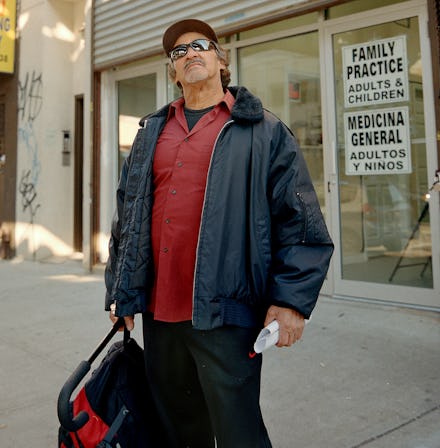A New York City Woman Is Fighting Back Against Catcalling in a Genius Way

When it comes to street harassment, we tend to direct our scrutiny toward the victim. Who is she? What does she look like? What can she do to prevent it? What does she think about it?
Some of this attention is good: The victims, after all, are the ones who bear the brunt of the baggage that comes with catcalling, and they deserve our sympathy and consideration. But Caroline Tompkins, a 22-year-old photographer based in New York City, has taken a different approach. Instead of photographing the women on the receiving end of street harassment, she's turned the lens around — to the catcallers themselves.
She began taking pictures of her harassers when she moved to New York City for college in 2010.
"I'm not represented [in the shots] as a way to combat victim-blaming," Tompkins told Mic. The focus of stories about street harassment is often directed at women, she said, when it's arguably the men who should stand in the harshness of the spotlight.
She started "Hey Baby," which doubled as a class portfolio, as a way to battle the helplessness she felt by her harassers.
"Every time I stepped out of my house, it was a comment on my appearance," she said. "It was relentless. I needed to do it because I needed to react in some way. I needed to show that I wasn't just taking it and not doing anything."
Many of the early photographs were taken in the Bushwick and Bedford-Stuyvesant neighborhoods of Brooklyn, where she lived at the time. "It could have been 7 a.m. or 8 p.m. It doesn't matter. You could be late to work, and then [you also have to] think about being looked at in this way," Tompkins said.
Public space, private conversation. One of the problems with catcalling — and part of what makes it so awful — is its public yet intimate nature.
"It's this private thing they're telling you, in a private way, but in a public space," Tompkins said. "I wanted to them to feel some consequence."
Given the public nature of street harassment, this begs the question of who, if anyone, should punish these men. Tompkins admits it's a tricky issue.
"There's no real grounds in terms of whose responsibility it is to stop it. It's kind of the law versus social norm," she said. "But if I go to the police, what do I say? 'This guy said something shitty to me'?"
And that's exactly how the men approached it. When Mic asked Tompkins about the response from the men, she explained they always claimed their behavior wasn't that bad: "100% of the time, every time I tried to confront them in any way, it was always just, 'Well, I didn't rape you. I was just giving you a compliment.'"
It's a common trope. In August, a group of female Fox News hosts debated the issue, saying of street harassment — which, let it be stressed for the billionth time, is not a compliment — "Men are gonna be that way, what can you do? They mean it in a nice way." And the New York Post recently ran and editorial with the headline declaring: "Hey ladies — catcalls are flattering! Deal with it."
Many of Tompkins' classmates and professors have reacted this way. Often it was older women who would say tell her, "Oh, I wish I got complimented by men. You should feel lucky."
It should be noted that some women do indeed feel this way, and that's absolutely their prerogative. But as Debjani Roy, deputy director of Hollaback, a nonprofit organization and movement to end street harassment, told Al Jazeera America, "From a very young age we are conditioned to believe that this is validation for who we are and how we should feel about ourselves." In other words, it's difficult not to internalize something that's been drummed into your head since you can talk.
In the end, it's not about women — it's about men. Catcalling is inherently performative in nature: it ends up being more about the person carrying it out than his target, something Tompkins tries to stress with "Hey Baby."
"It's about enforcing your masculinity," she said. "Public space is historically male, and private space is historically female. [It's] a reaction to a woman broaching public space. It's showing other men, 'I can do this, I'm masculine.'"
There are problems, of course, with Tompkins' approach. Focusing on the men is a balancing act. On one hand, it's important to publicize their aggression; on the other, it's dangerous to give street harassers too much attention.
There's also the racial component: Tompkins herself is white, and all of the men she's photographed are people of color. (This may have been a function of where she was; Bushwick and Bedford-Stuyvesant are predominantly African-American and Hispanic.)
"I definitely got a lot of talks about this," she said. "It turned into race and class issues within the catcalling discussion."
But Tompkins sees it as a valuable part of the conversation, one that encouraged her to think outside herself: "I'm a white woman [with] privilege. I understood that was problematic. It's something that I struggle with, that part of the gentrification process — how the system is."
In the end, though, it's about helping to put an end to the behavior.
"I wanted to do it because I wanted it to stop. I understand that I'm not going to be the person to make it stop. Legitimizing it was my biggest driving force," she said.
It's a worthy pursuit, and one worth continuing. For every woman like Tompkins, there's another too afraid to speak up, and "Hey Baby" provides that voice.
Image Credit (all): Caroline Tompkins